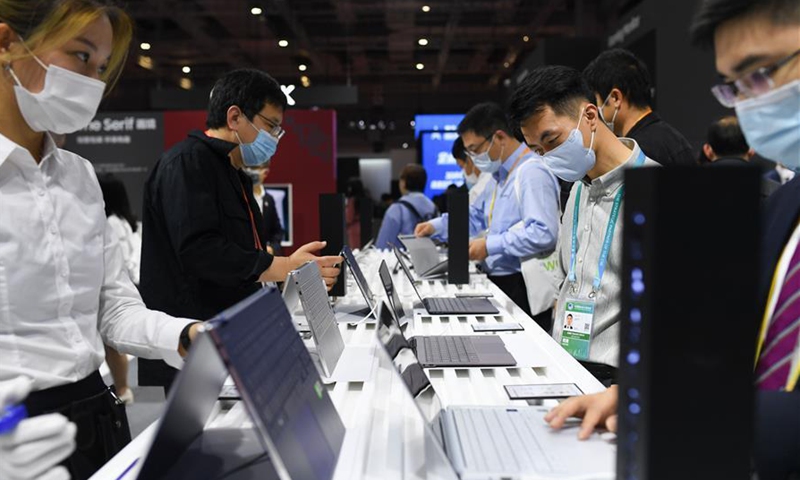Bad news for South Korea. Their foundry utilization rate already is bad with the Samsung yield scandal and as of now I don't believe they have even a single major customer. Could Samsung drop out of the leading edge race?
South Korea chip sales to China almost halve in January under US pressure
By GT staff reporters Published: Feb 02, 2023 09:37 PM

Visitors gather at the booth of Samsung at the Consumer Goods exhibition area during the 3rd China International Import Expo (CIIE) in Shanghai, on November 7, 2020. File photo:Xinhua
South Korea's semiconductors export to China, its largest trade partner, almost halved in January, impacted by the US' stepped-up chip war against China. But Chinese experts said South Korean chipmakers can't afford to lose the massive Chinese market.
They urged South Korea not to follow the US government in tightening chip export controls, and should continue to maintain global industrial and supply chain stability together with China.
The Ministry of Trade, Industry and Energy announced on Wednesday that South Korea's exports in January fell 16.6 percent year-on-year to $46.3 billion. Chip sales, the country's top export item, plunged 44.5 percent to $4.8 billion.
"Prices of core semiconductor components like DRAM, NAND and memory chips plunged as demand weakened and backlogs piled up, heavily damaging overall chip exports," it said in a press release on the South Korean government website.
In January, South Korea's total exports to China tumbled by 31.4 percent to $9.2 billion, the eighth consecutive monthly decline.
Sales of semiconductors to China slid 46.6 percent, while exports of petrochemical products to China dropped 22 percent, according to the South Korean ministry.
Along with falling chip exports came higher inventories at leading chipmakers including South Korea's Samsung and SK Hynix. US chip export curbs disrupted global chip supplies while global demand for consumer electronics plunged amid recessionary expectations in some developed countries, Xiang Ligang, a veteran telecom industry observer, told the Global Times.
In the fourth quarter of 2022, SK Hynix posted a loss for the first time in 10 years, according to a press release the company sent to the Global Times on Wednesday. Revenues stood at 7.699 trillion won ($6.3 billion), while the net loss was 3.524 trillion won.
Regarding exports of US semiconductor equipment to China, the company said during third-quarter earnings call in October that it would work closely with governments, customers and partners to prepare against external uncertainties and ensure business continuity, according to a transcript of the meeting.
South Korean chip firms may have difficulty in restoring lost export shortly whatever measures they take, Xiang said, and their operations may face greater challenges if they lose the Chinese market.
Chipmaking is an industry that requires close global cooperation. The US takes the lead in chip design, European companies such as ASML provide advanced manufacturing equipment, Japan has many upstream materials like photoresist, while South Korea is an important memory chip producer and the island of Taiwan dominates the foundry market.
However, South Korea faces increasing pressure from the US to join a chip circle excluding China. Japan and the Netherlands reportedly agreed to a chip control deal with the US.
Some South Korean firms have facilities for making NAND flash memory chips in China while a large proportion of dynamic random access memory (DRAM) chips are produced in South Korea and then exported to China, according to Han Xiaomin, general manager of Jiwei Insights in Beijing.
South Korean chipmakers may relocate their manufacturing to other countries such as Singapore and Vietnam so as to continue supplying China to maintain their share in the Chinese market, Han said, adding that "this would affect South Korea's foreign trade and local employment.
You are using an out of date browser. It may not display this or other websites correctly.
You should upgrade or use an alternative browser.
You should upgrade or use an alternative browser.
Chinese semiconductor industry
- Thread starter Hendrik_2000
- Start date
- Status
- Not open for further replies.
I think you should give Paul Triolo a break. I upload my Seeking Alpha articles for FREE on this thread for all to read. Paul Trioli is a SUBSCRIBER to my un-abridged Seeking Alpha articles, paying hundreds of USD to read them. If you block me, I will stop supplying my articles here!Haven't you say don't quote Paul Triolo in this thread?
The domestic GPU manufacturer Moore Threads officially announced that it has recently teamed up with Ziguang to win an order for the desktop computer procurement project of a large state-owned bank. The computer model that won the bid this time is "UNIS D3812 G2", and the localization rate of the whole machine exceeds 85%, including the MTT S30 multi-function desktop graphics card equipped with Moore thread




Cross post from the other thread, @WTAN Sir your comment it's either 70 or 90 that can support an EUVL machine.
Bro should be posted in the Semiconductor thread, what interest me is this " Started in 2019 and expected to be completed by the end of 2025, the HEPS can provide 60 to 70 beamlines at high brightness with more than 90 experimental stations."
Bro should be posted in the Semiconductor thread, what interest me is this " Started in 2019 and expected to be completed by the end of 2025, the HEPS can provide 60 to 70 beamlines at high brightness with more than 90 experimental stations."
Strangelove said:

China's latest high-energy synchrotron radiation light source facility, the High Energy Photon Source (HEPS), on Wednesday installed its first pre-aligned unit inside the storage ring tunnel, kicking off the comprehensive construction of the HEPS accelerator.A
news.cgtn.com
China's fourth-generation light source facility installs new unit
China's latest high-energy synchrotron radiation light source facility, the High Energy Photon Source (HEPS), on Wednesday installed its first pre-aligned unit inside the storage ring tunnel, kicking off the comprehensive construction of the HEPS accelerator.
A crucial part of the light source for accelerating electrons and generating synchrotron radiation, the storage ring is designed to achieve ultra-low emittance when charging particle beams and thus requires high precision for the construction.
Scientists and engineers at the Institute of High Energy Physics (IHEP) under the Chinese Academy of Sciences (CAS) have adopted an improved hybrid design of magnet systems and made them standard cells that can be pre-assembled in labs at higher precision.

Workers install a pre-aligned unit inside the HEPS storage ring tunnel, February 1, 2023. /IHEP
At a circumference of 1,360.4 meters, the storage ring would need 288 of such pre-collimated units, according to Qu Huamin, the chief engineer of the project.
The HEPS accelerator consists of three separate accelerators – the storage ring, the booster and the linear accelerator or linac – which together provide high-quality synchronized light for the beamlines.

An illustration of the HEPS accelerator structure. /IHEP
Located in Huairou District to the north of suburban Beijing, the facility takes up an area of more than 20 soccer fields. It is China's first fourth-generation synchrotron source and one of only a handful of such facilities in the world.
Started in 2019 and expected to be completed by the end of 2025, the HEPS can provide 60 to 70 beamlines at high brightness with more than 90 experimental stations.
Click to expand...
Not detection, quality controlNanda Optoelectronics: Defect detection equipment plays an important role in the detection of photoresist for chips below 28nm
Nanda is not as capable as XinYang
havok: 南大ArF胶弄不好会被新阳超过
havok: XinYang could surpass Nanda in Arf photoresist
Nanda Optoelectronics: Defect detection equipment plays an important role in the detection of photoresist for chips below 28nm
Q: In addition, some investors mentioned that the company's ARF photoresist project has been verified for one and a half years since it passed the acceptance of the expert group in July 2021 and has been verified by various chip companies. May I ask your company's photoresist project? What about verification? When will it be able to pass the verification and mass production, please give investors an assurance, the specific time, is it still possible?
A: Nanda Optoelectronics said that its subsidiary Ningbo Nanda Optoelectronics is actively carrying out customer verification of ArF photoresist. Two products have passed the verification, and many products are currently undergoing certification by many customers.
Very poor answer by Nanda. They seem to be stuck somewhere for some reason, but they don't say where they are stuck. They are not able to move to volume production, nor can give a possible date for production.
Japanese restrictions will begin in Spring
Japan to restrict chip manufacturing machine exports to China - Kyodo
Japan's government will begin restricting exports of advanced semiconductor manufacturing equipment to China in Spring after it amends a foreign exchange law to allow the change, Kyodo News reported on Saturday.
The new regulation will not mention China specifically in a bid to reduce the risk of retaliation by Beijing, the report said, without saying where it obtained the information.
- Status
- Not open for further replies.
